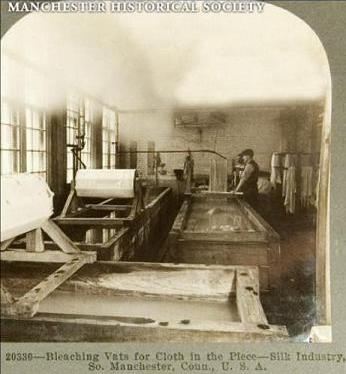



So. Manchester, Conn., U.S.A.
After weaving the greater part of the cloth goes to the dye-house to be dyed or printed as the case may be. Cloth made from raw silk is first boiled with soap to remove the gum and then washed. This process is technically known as "boiling off." The cloth is then taken to the dye-house and dyed the desired color.
Some yarns, both reeled and spun, are dyed in the skein, before being woven into cloth. This is called skein dyeing, as distinguished from piece dyeing. The dyer boils the skeins in soap and water to free them from gum, and to give them the desired softness and lustre. This takes away from the silk from twenty to thirty percent of the weight, leaving it on the average twelve ounces to the pound. Next it is put in the dye vat, and the dyer may or may not, by use of metallic substances in the dye, make the silk heavier and thicker than it naturally would be.
Black or dark colored silk is weighted sufficiently to make up partly for the loss in boiling. Light colors do not bear so much weighting. It injures and weakens the texture. Any silk, if heavily loaded, will break easily because of the particles of dye, and burn smoulderingly into a grey ash instead of a crisp cinder.
This picture gives us a view of the bleaching vats for the cloth in the piece. The vat is filled with the bleaching liquor and the cloth runs back and forth through it over the reel in the center.
For pictures and contemporary information on the Dye House in the
"Cheney Brothers National Historic Landmark District" page, click here.

 )
)